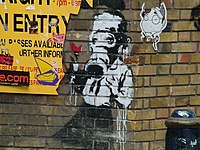This article needs additional citations for verification. (August 2014) |

Guerrilla art is a street art movement that first emerged in the UK, but has since spread around the world and is now established in most countries that already had developed graffiti scenes. In fact, it owes so much to the early graffiti movement, in the United States guerrilla art is still referred to as 'post-graffiti art'.
Guerrilla art differs from other art forms in it has no external boundary between the image and the environment. While a traditional painting can be moved from one gallery to another without the meaning or the artistic credibility of the piece being affected, street art is environmental, the surface to which it is applied to being as fundamental to the piece's meaning as that which is applied. Without the dynamics of modern life, guerrilla art is reduced to 'art for arts sake' and would be defined by what it is as opposed to what it does.
The production of guerrilla art is focused on cause and effect, not the material piece itself. It aims to produce an effect within the minds of those people who live within the environment being altered. It does not necessarily aim to produce meaningful art in itself.
